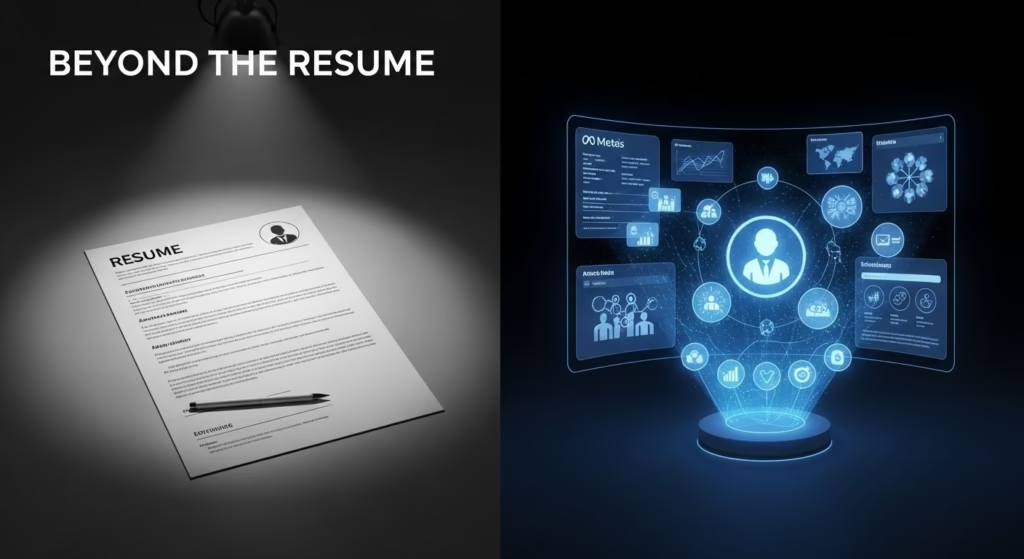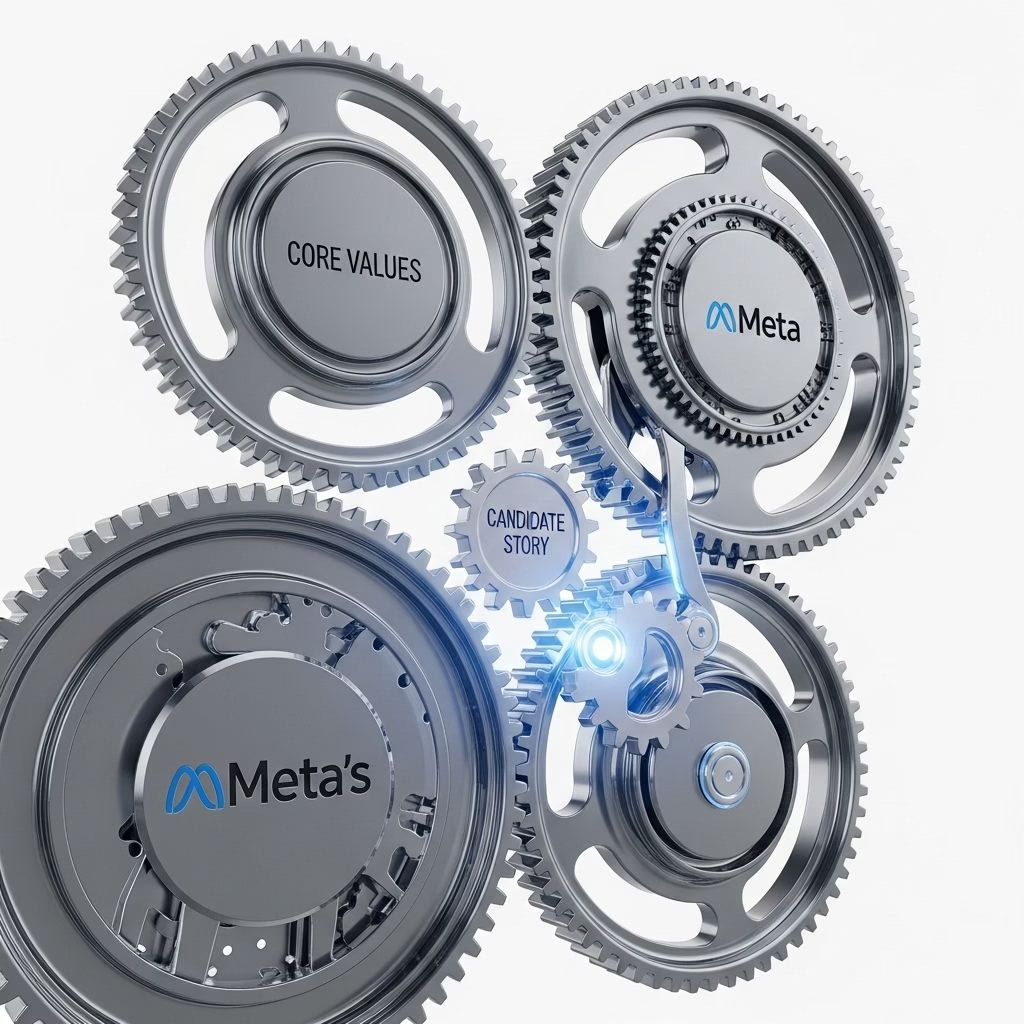Beyond the Resume: Aligning Your Career Story with Meta’s Core Values (Culture Fit)

You’ve done it. You’ve polished your resume until it shines, networked your way to a referral, and crafted the perfect application. Now, you’ve landed the first crucial step: the recruiter screen with Meta. You’re qualified, you’re experienced, and you’re ready. But as many brilliant candidates discover, a flawless resume is only the price of admission. The real challenge—and the key to unlocking an offer—is proving you have the right culture fit.
At a company as mission-driven as Meta, “culture fit” isn’t about whether you’d be fun to grab a coffee with. It’s a rigorous assessment of how well your professional DNA aligns with their core values. These values are the company’s operating system, guiding everything from product decisions to team collaboration. Your ability to demonstrate this alignment, to weave these values into your career story, is what separates a promising candidate from a future Metamate. This guide will walk you through how to decode Meta’s core values and use them to ace your recruiter screen and behavioral interviews.
Why Meta Obsesses Over Core Values (And Why You Should Too)
Think of Meta’s core values as the source code for its culture. They aren’t just inspirational phrases on a wall; they are the practical, everyday principles that dictate how employees are expected to think, act, and innovate. When a recruiter or hiring manager assesses for culture fit, they’re really asking:
- Do you have a bias for action and thrive in a fast-paced environment? (Move Fast)
- Do you think about the long-term implications of your work? (Focus on Long-Term Impact)
- Are you passionate about creating exceptional products for billions of people? (Build Awesome Things)
- Can you communicate openly and honestly, even when it’s difficult? (Be Direct and Respect Your Colleagues)
- Do you prioritize the success of the company and your team over your own? (Meta, Metamates, Me)
Understanding and internalizing these values is non-negotiable. Your entire interview process, from the initial recruiter screen to the final-round behavioral interviews, is designed to uncover evidence of this alignment. By learning to speak this language, you’re not just preparing for an interview; you’re demonstrating your potential to be a high-impact contributor from day one.

Decoding Meta’s Core Values: From Corporate-Speak to Actionable Insights
Let’s break down each of Meta’s core values. For each one, we’ll translate what it means in practice and explore the types of behavioral questions designed to test it.
1. Move Fast
What it really means: This is Meta’s most famous value. It’s about a relentless bias for action, speed in execution, and learning through rapid iteration. It doesn’t mean being reckless; it means prioritizing momentum over perfection, making calculated decisions with incomplete data, and recovering quickly from mistakes. It’s about building, shipping, learning, and repeating—at pace.
Behavioral questions you might hear:
- “Tell me about a time you had to deliver a project under a very tight deadline.”
- “Describe a situation where you had to make an important decision without all the information you wanted.”
- “Walk me through a project that failed. What did you learn, and how quickly did you pivot?”
How to align your story: Look for examples where you took initiative instead of waiting for permission, delivered a minimum viable product (MVP) to get feedback early, or simplified a complex problem to accelerate progress. Highlight your ability to be decisive and learn from outcomes, both good and bad.
2. Focus on Long-Term Impact
What it really means: This value acts as a counterbalance to “Move Fast.” While Meta values speed, it’s not at the expense of building something sustainable and meaningful. This is about prioritizing work that will deliver value for years to come, not just for the next quarter. It means thinking about scalability, solving root problems instead of symptoms, and making investments today that will pay off in the future.
Behavioral questions you might hear:
- “Describe a time you had to choose between a short-term win and a long-term goal. How did you decide?”
- “Tell me about a project where you invested extra time upfront to ensure future scalability or stability.”
- “How do you measure the success of your work? Give me an example of a project with lasting impact.”
How to align your story: Your best stories will involve strategic thinking. Talk about times you resisted a “quick fix” in favor of a more robust solution. Discuss projects where you not only met the immediate goal but also created a framework, process, or system that benefited the team or company long after you moved on.
3. Build Awesome Things
What it really means: This is about ambition, craftsmanship, and a deep sense of ownership. It’s about setting a high bar for quality and pushing the boundaries of what’s possible. This value speaks to the passion for building products that are not just functional, but also delightful and impactful on a massive scale. It means caring about the details and taking immense pride in your work.
Behavioral questions you might hear:
- “Tell me about the project you are most proud of. What made it special?”
- “Describe a time you went above and beyond the project requirements to deliver something exceptional.”
- “How do you incorporate user feedback to make a good product great?”
How to align your story: Showcase your passion. Choose a project where you were deeply invested. Explain the “why” behind your decisions and how you obsessed over the user experience or the technical quality. Demonstrate a sense of personal responsibility for the final outcome.
4. Be Direct and Respect Your Colleagues
What it really means: Meta’s culture thrives on open, candid feedback. This value is about communicating with clarity and honesty, even when it’s uncomfortable. It’s about challenging ideas (not people) and being able to receive critical feedback gracefully. The “respect” part is crucial: directness should be delivered with empathy and the assumption of good intent, always in service of a better outcome.
Behavioral questions you might hear:
- “Tell me about a time you had a significant disagreement with a colleague. How did you handle it?”
- “Describe a time you had to give difficult feedback to a peer or manager.”
- “Walk me through a situation where you received tough feedback. How did you react?”
How to align your story: Focus on professionalism and a shared goal. When describing a disagreement, frame it as a debate over the best path forward for the project, not a personal conflict. Detail the steps you took to listen, present your data-backed view calmly, and work towards a resolution. For receiving feedback, show that you listened, sought to understand, and used the input to improve.
5. Meta, Metamates, Me
What it really means: This is Meta’s take on “teamwork makes the dream work.” It’s a hierarchy of priorities: what’s best for the company (Meta) comes first, followed by what’s best for your team (Metamates), and finally your own personal interests (Me). It’s about being a great collaborator, proactively helping others, and making decisions that benefit the collective good, even if it means deprioritizing a personal pet project.
Behavioral questions you might hear:
- “Describe a time you had to make a sacrifice for the good of your team.”
- “Tell me about a time you helped a colleague who was struggling.”
- “Give an example of a time you put the company’s or team’s needs ahead of your own goals.”
How to align your story: Your examples should be rich with “we,” not “I.” Talk about how you shared credit, mentored a junior team member, or took on unglamorous work because it was critical for the team’s success. Demonstrating that you are a “we” player is fundamental to proving your Meta culture fit.
Weaving Your Story: From the Recruiter Screen to the Behavioral Deep Dive
Now that you’ve decoded the values, it’s time to integrate them into your narrative. This isn’t about name-dropping “Move Fast” in every sentence. It’s about telling stories where the values are the undeniable theme.
Mastering the Recruiter Screen
The initial recruiter screen is your first and most important culture fit test. Recruiters are experts at spotting alignment (or lack thereof). When they ask “Why Meta?” or “Tell me about yourself,” this is your chance.
Bad Answer: “I want to work at Meta because it’s a top tech company with great benefits, and I want to work on products that have a big scale.”
Good Answer: “I’m incredibly drawn to Meta’s ‘Focus on Long-Term Impact.’ In my last role at Company X, I led a project to refactor our core database. It was a challenging six-month effort with no immediate customer-facing benefit, but I championed it because I knew it would unlock faster development and improve stability for years to come. I’m excited about the opportunity to bring that same long-term thinking to the challenges at Meta.”
See the difference? The second answer directly connects personal experience to a core value, providing a concrete example as proof. It transforms a generic statement into a compelling piece of your career story.
Acing the Behavioral Interview with the STAR Method
In the later-stage behavioral interviews, you’ll go deeper. The STAR method (Situation, Task, Action, Result) is your best friend here. It provides a clean structure to ensure your stories are clear, concise, and impactful.
Let’s apply it to a question testing “Be Direct and Respect Your Colleagues”: “Tell me about a time you disagreed with a manager’s decision.”
- Situation: “My manager proposed a new feature launch strategy that prioritized speed by cutting two key testing phases. The team was already moving fast to meet our deadline.”
- Task: “My goal was to voice my concerns about the potential risk to product quality and user trust, without undermining my manager or slowing down the team unnecessarily.”
- Action: “I gathered data from a past incident where a similar shortcut led to a major bug. I scheduled a 1-on-1 with my manager and presented the data, framing my concern around our shared goal of a successful, stable launch. I said, ‘I’m fully on board with the need to move fast, but I’m concerned this specific shortcut could jeopardize our long-term impact by eroding user trust. Could we explore a compromise, like a limited beta test?'”
- Result: “My manager appreciated the data-driven approach and the fact that I offered a solution. We agreed on a one-week, targeted beta test. We caught a critical bug that would have been disastrous. The launch was only delayed by three days, and we protected our user experience and the project’s long-term success. It also built more trust between my manager and me.”
This STAR response is powerful because the Actions are dripping with Meta’s values. It shows directness, respect, data-driven thinking, and a balanced understanding of both “Move Fast” and “Focus on Long-Term Impact.”
Red Flags: What Signals a Poor Culture Fit?
Just as important as knowing what to do is knowing what to avoid. Interviewers are trained to spot red flags that suggest a poor culture fit. Be mindful of:
- Blaming Others: In your stories, always take ownership. Even if a project failed due to external factors, focus on what you learned and what you would do differently.
- Focusing on “I” over “We”: Constantly highlighting your individual achievements without acknowledging your team signals a poor fit for the “Meta, Metamates, Me” value.
- Analysis Paralysis: Describing situations where you waited for perfect data or couldn’t make a decision runs directly counter to “Move Fast.”
- Being Theoretical: Don’t talk about what you would do. Talk about what you did. Meta values builders and doers. Your past behavior is the best predictor of your future performance.
- Avoiding Disagreements: If asked about a conflict and you say you’ve never had one, it suggests you either avoid important conversations or lack self-awareness. Disagreement is a normal part of innovation.
Conclusion: Your Story is Your Strategy
Getting a job at Meta is a marathon, not a sprint. While your skills and experience get you in the race, your ability to demonstrate alignment with Meta’s core values is what will carry you across the finish line. Stop thinking of the interview process as a test of your resume and start seeing it as an opportunity to tell your career story—a story that proves you don’t just have the right skills, but the right mindset.
Before your next conversation, take the time to reflect. Mine your past for compelling examples that embody each value. Practice articulating them using the STAR method. When you can seamlessly connect your personal narrative to Meta’s cultural DNA, you’re no longer just a candidate. You’re a potential Metamate.
FAQ: Meta Culture Fit & Core Values
Is ‘culture fit’ just a way for Meta to hire people who are all the same?
Not at all. Meta’s focus on values is about aligning on a common way of working and problem-solving, not on personality, background, or interests. In fact, diversity of thought is crucial for innovation. ‘Be Direct and Respect Your Colleagues’ encourages different viewpoints. The goal is to find people who, despite their diverse perspectives, share a commitment to these core operational principles.
What if my past experience is from a much slower-paced company? How can I show I can ‘Move Fast’?
Focus on specific instances where you took initiative to accelerate a project, even within a slow environment. Did you build a prototype on your own time? Did you simplify a process to get results faster? Did you make a decisive call with limited data? Highlight these moments to show your inherent bias for action, proving you can thrive at Meta’s pace regardless of your previous context.
How many examples should I prepare for each of Meta’s core values?
Aim to have at least two distinct and strong examples for each of the five core values. This gives you flexibility in the behavioral interviews, as one example might fit multiple values. Your best stories will often demonstrate a combination of values, such as balancing the need to ‘Move Fast’ with a ‘Focus on Long-Term Impact.’
Can I still be a good culture fit at Meta if I’m an introvert?
Absolutely. Being a culture fit is not about being the loudest person in the room. Values like ‘Be Direct and Respect Your Colleagues’ can be demonstrated just as effectively through thoughtful, well-reasoned writing or in a focused 1-on-1 conversation as in a large group meeting. Meta values the impact of your contributions and your collaborative spirit, not your level of extroversion.
What is the most important Meta core value to demonstrate?
While all are important, ‘Meta, Metamates, Me’ and ‘Be Direct and Respect Your Colleagues’ are foundational to collaboration. You can be a fast, brilliant builder, but if you can’t work effectively with others, you won’t succeed at Meta. That said, the specific values emphasized may vary slightly by role. For a startup-like team, ‘Move Fast’ might be key, while for an infrastructure team, ‘Focus on Long-Term Impact’ could be paramount. The strongest candidates show a balanced understanding of all five.



